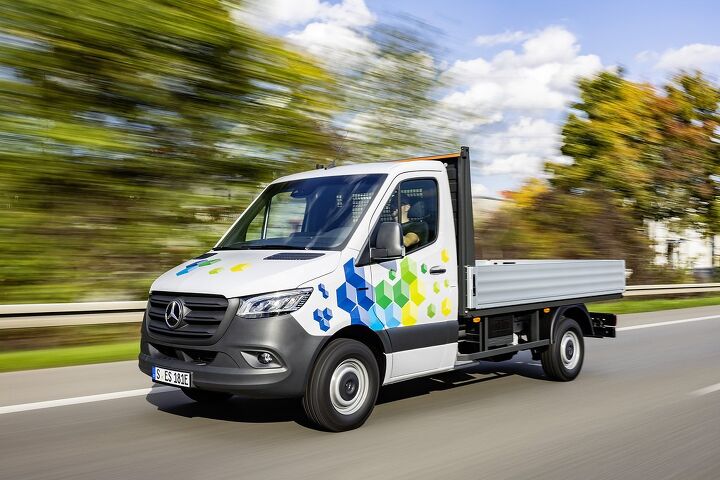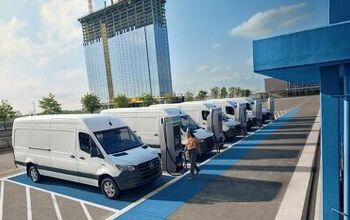2023 Mercedes-Benz ESprinter Electric Van Debuts

Mercedes-Benz has officially debuted the all-electric version of the Sprinter and confirmed it will arrive in the United States sometime after the summer solstice. While the van will come in an array of formats to suit varying cargo needs, the initial run will be the long wheelbase variant with the highest roof and largest battery the Germans have to offer. But different versions are said to be forthcoming. Storage in the eSprinter seems to be more or less on par with its combustion-driven counterpart, though it cannot hold quite as much weight due to the heft of the battery pack. Range likewise seems useful, though the electric van will undoubtedly be better suited to localized delivery routes than any long-haul jobs.
As of now, we only have mileage estimates based on the European WLTP testing cycle, which tends to be a little more forgiving than the conservative (and arguably more accurate) estimates calculated by the EPA. The eSprinter’s battery (offering 113 kWh of usable capacity) is supposed to yield 311 miles in the city driving and 249 miles on the highway before it runs out of power. Those numbers will absolutely come down a bit once the EPA runs some tests and there will likewise be some changes depending on how much weight the van is carrying. But it seems like a useful amount of range for a company wanting to leverage the eSprinter for local deliveries requiring frequent stops.
In terms of just how much it can haul. The model we’ll be getting is said to have 88 cubic feet of cargo capacity and a GVWR of 4.25 tons. That’s a little less than the standard Sprinter, albeit close enough for it not to make a big difference unless the weight of your cargo is a major factor.
With there about to be a deluge of electrified vans on the market, it’s difficult to predict whether the eSprinter will be a big hit. Mercedes noted that the model compares closely to the similarly sized diesel Sprinter offering up 170 hp and 295 lb-ft of torque.
The electric version can be had with either 134 or 201 horsepower – with torque always sitting at a useful 295 lb-ft. Power comes via a singular electric motor located at the back, driving the rear wheels. While Mercedes does offer a high-output diesel variant that trumps those figures, the EV does have instantaneous torque that should help move things from a dead stop. Just don’t expect it to drive like a sports car. The added weight of the battery isn’t going to help the eSprinter win any drag races and the model has been capped at 75 mph anyway.
Ultimately, this thing is a commercial delivery van that exists to help Mercedes rationalize its transition to EVs. While the automaker said it would like customers to buy eSprinters for their small business or personal recreational vehicle, it’s obviously targeting fleet sales with this one.
Operators with access to fast charging are supposed to see the eSprinter’s energy state go from 10 to 80 percent in about 42 minutes. That’s hardly on the cutting edge, though likely sufficient for someone hoping to use this as a work vehicle that’ll never stray far from home base.
Otherwise, it’s not all that different from the standard Sprinter vans and comes with Mercedes’ latest infotainment system. This includes enhanced navigation with “Electric Intelligence” – basically a fancy pants range estimation tool that uses the vehicle’s connectivity to incorporate things like elevation, traffic, and any changes that have been made to the route. It’ll undoubtedly be handy for Amazon drivers. But maybe not for someone using the eSprinter for their plumbing or locksmithing service. Though the feature will also recommend convenient charging stations based on your current route, should the need arise.
Considering all of the above, there’s really nothing about the Mercedes eSprinter that makes it seem ready to blow everything else out of the water. It’s very obviously a compliance vehicle created in anticipation of stringent vehicle regulations (including those pertaining to connectivity) that are being put into place inside the European Union. Numerous cities are similarly poised to ban combustion vehicles from entering in the coming years and companies are going to need to have something in their fleet to get around that. Mercedes is simply offering a solution while it attempts to electrify the rest of its lineup.
Mercedes-Benz Vans has already stated that starting in 2025, all midsize and large vans will be based upon its updated modular architecture and become electric-only. It seems a little shortsighted from a global perspective. But it may also be the brand’s only recourse if it expects to keep selling vehicles inside of Europe past 2030.
It’s difficult to say whether the Sprinter will be an ideal choice for fleet managers seeking to go electric. While it does offer most of what’s available on the liquid-fueled Sprinter van, it still requires a few compromises and likely won’t shine all that brightly unless there’s a dedicated place to charge it every day. While knowing the price of the eSprinter would help to determine its commercial viability, Mercedes doesn’t have anything for us yet.
Expect a pricing announcement closer to launch, which is estimated to be in the second half of 2023. There’s also a chance that the model could qualify for the $7,500 EV tax credit due to the fact that models being sold in the U.S. are being manufactured in South Carolina. Then again, the updated domestic content requirements could stymie those prospects.
[Images: Mercedes-Benz]
Become a TTAC insider. Get the latest news, features, TTAC takes, and everything else that gets to the truth about cars first by subscribing to our newsletter.

A staunch consumer advocate tracking industry trends and regulation. Before joining TTAC, Matt spent a decade working for marketing and research firms based in NYC. Clients included several of the world’s largest automakers, global tire brands, and aftermarket part suppliers. Dissatisfied with the corporate world and resentful of having to wear suits everyday, he pivoted to writing about cars. Since then, that man has become an ardent supporter of the right-to-repair movement, been interviewed on the auto industry by national radio broadcasts, driven more rental cars than anyone ever should, participated in amateur rallying events, and received the requisite minimum training as sanctioned by the SCCA. Handy with a wrench, Matt grew up surrounded by Detroit auto workers and managed to get a pizza delivery job before he was legally eligible. He later found himself driving box trucks through Manhattan, guaranteeing future sympathy for actual truckers. He continues to conduct research pertaining to the automotive sector as an independent contractor and has since moved back to his native Michigan, closer to where the cars are born. A contrarian, Matt claims to prefer understeer — stating that front and all-wheel drive vehicles cater best to his driving style.
More by Matt Posky
Latest Car Reviews
Read moreLatest Product Reviews
Read moreRecent Comments
- Flashindapan I always thought these look nice. I was working at a Land Rover dealership at the time the LR3 came out and we were all impressed how much better it was then the Discovery in just about every measurable way.
- Bd2 If I were going to spend $ on a ticking time bomb, it wouldn't be for an LR4 (the least interesting of Land Rovers).
- Spectator Wild to me the US sent like $100B overseas for other peoples wars while we clammer over .1% of that money being used to promote EVs in our country.
- Spectator got a pic of that 27 inch screen? That sounds massive!
- MaintenanceCosts "And with ANY car, always budget for maintenance."The question is whether you have to budget a thousand bucks (or euro) a year, or a quarter of your income.








































Comments
Join the conversation
It leaves the loading dock/loading are in the morning. It gets parked in the same place. Bubba/Bubbette plugs in and it charges overnight. Driver forgot to plug in?
First time a warning, second time no pay while their vehicle is recharging. That problem will correct itself.
Amazon, UPS and mail delivery are the perfect applications for electric vehicles, except, perhaps, in sub-freezing climates, when the drivers shouldn't be out in the elements, anyway. 300 miles of city driving is more than enough for most delivery routes.
We have the Lightning F-150... when will we see an electric mini-truck? Two seats, a seven foot bed, 150 HP, come on, guys, step it up!